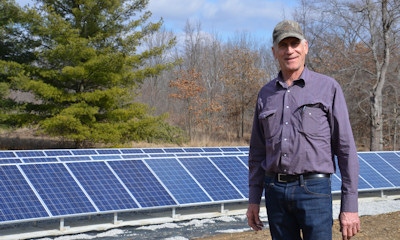
You may not be ready to invest in solar panels just yet. Les Zimmerman has, and he likes what he sees. One thing he enjoys most is when he watches his electric meter run backwards on sunny afternoons.
“I really like to just stand there and watch it,” says Zimmerman, Vermilion County. An avid conservationist and 2016 Indiana Association of Soil and Water Conservation Districts Supervisor of the Year, he also considers himself an environmentalist. Capturing his own energy to power his house makes sense to him.
Here are five key points about Zimmerman’s venture into solar power. Some may surprise you.
1. Do it because you want to be environmentally friendly toward energy

SOLAR SENSE: Les Zimmerman likes the idea of using solar energy to produce his own electricity. It is captured by solar panels.
When you ask Zimmermann if the solar panels near his house are cost effective, he smiles. He talks about doing the right thing for the environment and enjoying watching the electric meter run in reverse as the solar system puts power into the grid. Cost savings isn’t the first thing he mentions.
2. It pays for itself in time
Solar panels aren’t an aggressive investment when it comes to return on your money, he says. At current electricity costs he figures that his system should pay for itself in 15 years. Because of upfront expenses, it isn’t a quick payoff. He figures that long-term, one might be looking at 5% return per year on the investment.
3. Surprise: late winter days can generate lots of electricity
You might think that the biggest benefit would come from the summer sun. Logic would say that is when the system would turn out the most electricity. Zimmerman says that’s not necessarily the case. “This time of year is actually a good time because of the angle of the sun,” he says. “It’s all about the angle of the sun.”
On a sunny day recently, the system was producing about 11 kilowatts in mid-afternoon. The system is rated to produce 12 kilowatts. The most Zimmerman has observed it produce is about 11.4 kilowatts.
4. Life span of system designed to exceed length of repayment time
The panels in Zimmerman’s system are rated to last 20 years, he says. And there is virtually no maintenance to the system. He hasn’t experienced a hailstorm, but believes they could withstand at least some hail because of their durable construction. Insurance companies write policies for solar panel installations, he adds.
5. When does he have to pay for electricity?
“The only time I pay is when I use enough electricity supplied by the utility to increase the reading on the meter,” he says. Since the meter runs backward when the system is producing at a high volume, even when it isn’t producing enough to meet all of the needs for his house, he doesn’t necessarily pay for electricity. It’s only when he uses more than the system has produced, he emphasizes.
The utility doesn’t pay to buy any electricity from Zimmerman that is produced from the system. However, his cost savings result from the electricity which the system produces for his home.
About the Author(s)
You May Also Like




